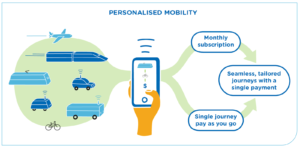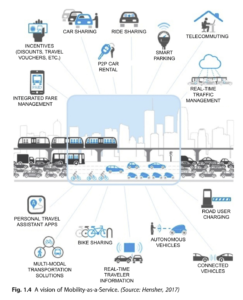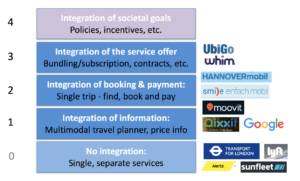 Mobility as a Service (MaaS) is the use of a single application to access multi-modal travel options through a single payment channel instead of multiple ticketing through different service providers. [1]
Mobility as a Service (MaaS) is the use of a single application to access multi-modal travel options through a single payment channel instead of multiple ticketing through different service providers. [1]
The user can create and pay for a journey that includes:
- public transport
- ride, car, bike sharing
- taxi or car rental/lease
- or a combination of these options.
Travel for the user becomes easy and efficient.
What is MaaS
MaaS centres around the user’s experience.
The use of an integrated system simplifies journey planning, particularly the inconvenient parts, by offering different transport options as a complete package. Previously these would be offered and owned by different service providers making for clunky and difficult route planning. Using real time information, a user can plan, book, and purchase their end-to-end journey via an online app, when travelling by public transport, rideshare or bike hire. [2]
MaaS is different from on-demand services because it uses a single interface to connect multiple transport modes whereas on-demand uses a single platform for one transport mode. [3]
A simple representation of MaaS is below:

Source: Future Transport NSW [4]
What makes up MaaS?
The nature of real-time journey planning, payment and booking of MaaS means that there is a complex relationship of many players involved across the end to end process, which includes mobility management providers, telecommunications operators, payment processors, public and private transport providers and local authorities.
MaaS integration
MaaS is generally made up of an integration across physical infrastructure, data, transport operators and MaaS aggregators.
Physical infrastructure is needed to support linking of different modes such as bus or train interchanges, bike or car sharing spaces at stations.
Data is essential to the success of integration ensuring that the range of transport options offered and real-time traffic updates are accurate.
Transport operators have introduced new modes of travel due to demands to expand service delivery, including bike sharing and car sharing, parking, carpooling, peer-to-peer car clubs, ride-hailing, or on-demand bus rides. [5]
MaaS aggregators provide the interface between mobility solutions and end users, allowing the user to plan, book and pay for different types of transport via the same application. [6]
A vision for MaaS could look like the following:

Source: Hensher, D. [7′
MaaS integration levels
MaaS can operate across different levels of integration, from no integration (single provider) to full integration of information, booking and payment, service offering. [8]
The below framework can be used to plan a business’ mobility goals.

Source: MaaS Alliance [9][
Examples of MaaS implementation
Companies like MaaS Global and MaaS Alliance are cross-sector industry collaborations and leading the future push for mobility.
Operators leading the transition include:
- Whim – a Finland-based MaaS aggregator
- Moovel – Daimler subsidiary from Texas
- Conduent – New Jersey-based former division of Xerox
- Trafi – offer mobility solutions for buses, bikes and shared cars in Vilnius and soon in Germany. [10]
Mobility pioneers in Asia Didi and Grab have been successful almost from day one growing faster than Uber or Lyft and taking significant market share.
Australian market for MaaS
In Australia MaaS is in its infancy, with most initiatives sitting at integration levels 0-1. Smart cards systems are a first step in integrating transport operators, payment and ticketing systems:
- Brisbane – Go Card; used on trains, trams, buses and ferries.
- Melbourne – myki Card; used on trains, trams and buses.
- Sydney – Opal Card; used on trains, trams, buses and ferries.
- Adelaide – Metrocard; used on trains, trams and buses.
- Perth – SmartRider; used on trains, buses and ferries.
- Hobart – Greencard; used on buses.
- Canberra – MyWay; used on buses.
- Darwin – Tap & Ride Card; used on buses. [11]

